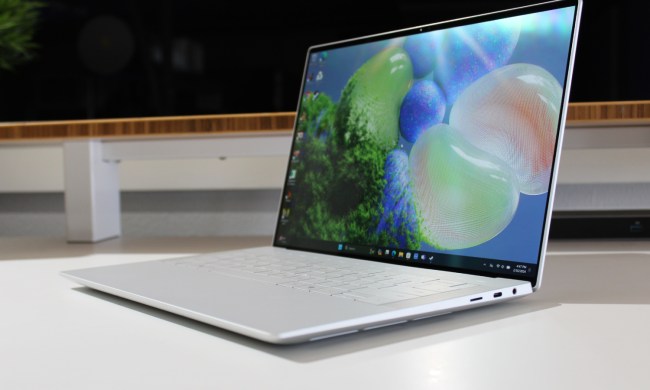It’s no secret that 15-inch laptops (and bigger) are the powerhouses of portable computing. They’re used for gaming, content creation, video editing, and serious work.
Two of the best laptops are the Dell XPS 15 and the Apple MacBook Pro 16, each of which recently received updates to faster CPUs and GPUs, but otherwise remained mostly the same. Both are excellent laptops that offer great performance, outstanding build quality, and excellent input options — but which one is right for you? Well, if it comes down to price, the XPS 15 the much more affordable option. That alone will make the decision easy for some people.
Specs
| Dell XPS 15 9530 | Apple MacBook Pro 16 | |
| Dimensions | 13.57 inches x 9.06 inches x 0.71 inches | 14.01 inches x 9.77 inches x 0.66 inches |
| Weight | 4.23 pounds | 4.8 pounds |
| Processor | Intel Core i5-13500H Intel Core i7-13700H Intel Core i9-13900H |
Apple M1 Pro Apple M1 Max |
| Graphics | Intel Iris Xe Intel Arc A370M Nvidia GeForce RTX 4050 (40W) Nvidia GeForce RTX 4060 (40W) Nvidia GeForce RTX 4070 (40W) |
Integrated Apple GPU |
| RAM | 8GB DDR5-4800MHz 16GB DDR5-4800MHz 32GB DDR5-4800MHz 64GB DDR5-4800MHz |
16GB 32GB 64GB (M1 Max) |
| Display | 15.6-inch 16:10 Full HD+ (1,920 x 1,200) IPS 15.6-inch 16:10 3.5K (3,456 x 2,160) OLED |
16.2-inch 16:10 Liquid Retina XDR (3456 x 2234) |
| Storage | 512GB PCIe SSD 1TB PCIe SSD 2TB PCIe SSD 4TB PCIe SSD 8TB PCIe SSD (2 x 4TB SSDs) |
512GB SSD 1TB SSD 2TB SSD 4TB SSD 8TB SSD |
| Touch | Optional | No |
| Ports | 2 x USB-C with Thunderbolt 4 1 x USB-C 3.2 Gen 2 1 x 3.5mm audio jack 1 x SD Card reader |
3 x USB-C 4 with Thunderbolt 4 1 x HDMI 2.0 1 x 3.5mm audio jack 1 x SD Card reader |
| Wireless | Wi-Fi 6 and Bluetooth 5.2 | Wi-Fi 6 and Bluetooth 5.0 |
| Webcam | 720p with infrared camera for Windows 11 Hello | 1080p |
| Operating system | Windows 11 | MacOS Monterey |
| Battery | 86 watt-hours | 100 watt-hour |
| Price | $1,499+ | $2,499+ |
| Rating | 3.5 out of 5 stars | 5 out of 5 stars |
Design
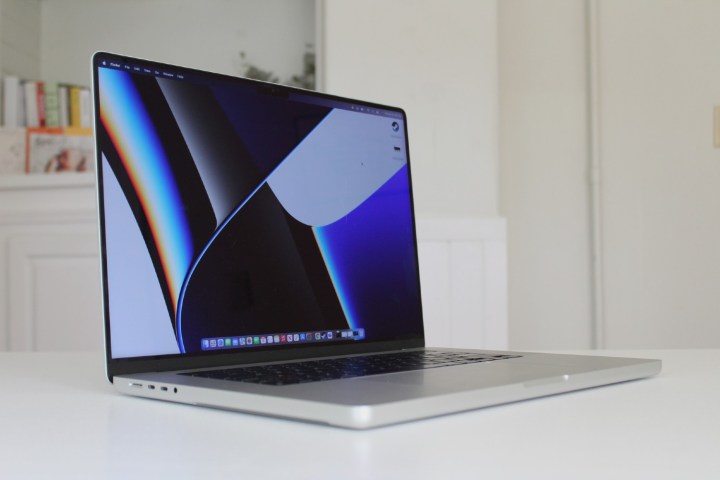
Your first decision is which operating system is right for you. If you have no preference, then read on. But if you’re a fan of one over the other, then the hardware won’t matter — your decision has already been made.
If it hasn’t, however, then you’ll be pleased to know that both laptops offer exceptional design and sturdiness. The XPS 15 combines machined aluminum and carbon fiber (black keyboard deck) or glass fiber (white keyboard deck), while the MacBook Pro 16 is constructed from a single chunk of aluminum. Both have a tight fit and finish and feel plenty rigid in hand.
Aesthetically, the MacBook Pro 16 is a simpler design. It’s either silver or space gray throughout, with only the black keyboard section and black Apple logo on the lid breaking up the color scheme. It’s a study in refined elegance, and while it’s a minimalist design, it still exudes quality. The XPS 15 is more elaborately designed, with silver or frost aluminum making up the lid and chassis bottom and a black carbon fiber or white glass keyboard deck creating a lovely contrast. The sides are double-anodized chrome that accentuates the streamlined chassis and provides extra protection against scratches. Both laptops are good-looking machines, and which is better depends on one’s subjective tastes.
Despite having relatively short travel at just 1mm, the MacBook’s Magic Keyboard keyboard is crisp, snappy, and responsive. It’s the best keyboard available on a laptop today. The keyboard on Dell’s XPS 15 is also excellent, with more travel and its own precise mechanism. Both keyboards have large keys and plenty of key spacing, which, combined with excellent switches, make them well-suited for long typing sessions.
The MacBook Pro 16’s touchpad is also a step above the XPS 15’s. While the Dell sports a fine touchpad that’s large by Windows 11 standards and supports Microsoft Precision touchpad drivers, it doesn’t compare to Apple’s expansive Force Touch touchpad. It takes a little time to get used to the MacBook’s haptic feedback method of registering “clicks” compared to the physical buttons on the XPS 15, but once you’re used to it, it becomes second nature. Apple’s touchpad also remains the most responsive when it comes to the plethora of multitouch gestures supported by MacOS.
The XPS 15 retains the 720p webcam of its predecessor, which can’t hold a candle to the excellent 1080p version in the MacBook Pro 16. The XPS 15 uses a fingerprint scanner and facial recognition to support Windows 11 Hello, which works well for logging in without a password. Apple has its Touch ID fingerprint reader that also allows for passwordless login. They’re both great solutions that work very well.
As for ports, there are some essential differences between the two. Apple has expanded connectivity on the MacBook Pro 16, offering a full-size HDMI port and full-size SD card reader to go with three USB-C ports with Thunderbolt 4 and a 3.5mm audio jack. Dell provides a less diverse range of connectivity, with just a USB-C 3.2 Gen 2 port, two USB-C ports with Thunderbolt 4 support, a 3.5mm audio jack, and a full-size SD card reader. Both laptops offer the latest Wi-Fi 6E and Bluetooth 5.2.
Performance
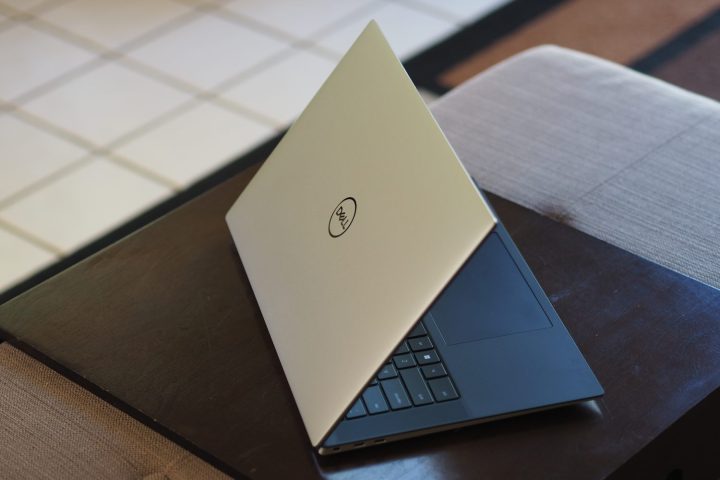
The MacBook Pro 16 can be equipped with Apple’s M2 Pro or M2 Max CPU. The former offers a 12-core CPU (eight performance and four efficiency) and a 16-core GPU. The latter is a 12-core CPU, but offers 30 or 38 GPU cores. Both are incredibly fast at CPU-intensive tasks and burn through creative workflows. We reviewed the MacBook with the M1 Pro chip, but we’ve included results from the MacBook Pro 14 with the high-end M2 Max as a proxy. The 16-inch model is likely to be slightly faster.
The Dell XPS 15 offers Intel’s 45-watt 13th-gen CPUs, including the Core i5-13500H (four Performance cores, eight Efficient cores, and 16 threads), the Core i7-12700H (six Performance cores, eight Efficient cores, and 20 threads), and the Core i9-12900HK (the same core and thread count as the Core i7, but a 5.4GHz max Turbo frequency versus 5.0GHz). The lineup offers improved performance over Intel’s 12th-gen CPUs and competes well against the M1 Pro in most of our benchmarks.
For example, when switched to its performance mode, the XPS 15 was faster than the M2 Max in our Handbrake test that encodes a 420MB video as H.265, but it fell behind in Geekbench 5 and Cinebench R23 in multi-core mode. In single-core tasks, Intel’s CPU is faster. The MacBook Pro 14’s M2 Max was slightly faster in the Pugetbench Premiere Pro benchmark that runs in a live version of Premiere Pro.
The primary area where the XPS 15 will exceed the MacBook Pro 16’s performance is in gaming, thanks to its discrete Nvidia GeForce RTX 4070 CPU, but even there, the difference won’t be extreme.
Both laptops are fast enough for creative applications, but the MacBook Pro 16 is the quicker option for demanding creators.
| Geekbench (single/multi) |
Handbrake (seconds) |
Cinebench R23 (single/multi) |
Pugetbench Premiere Pro |
|
| Dell XPS 15 (Core i7-13700H / RTX 4070) |
Bal: 1787 / 11978 Perf: 1830 / 11769 |
Bal: 79 Perf: 76 |
Bal: 1865 / 13386 Perf: 1868 / 13927 |
Bal: 866 Perf: 1023 |
| MacBook Pro 16 (M1 Pro 10/16) |
Bal: 1707/ 12605 Perf: N/A |
Bal: 95 Perf: N/A |
Bal: 1531 / 12343 Perf: N/A |
Bal: 977 Perf: N/A |
| MacBook Pro 14 M2 (M2 Max 10/38) |
Bal: 2668 / 14422 Perf: N/A |
Bal: 85 Perf: N/A |
Bal: 1608 / 14789 Perf: N/A |
Bal: 1093 Perf: N/A |
Display
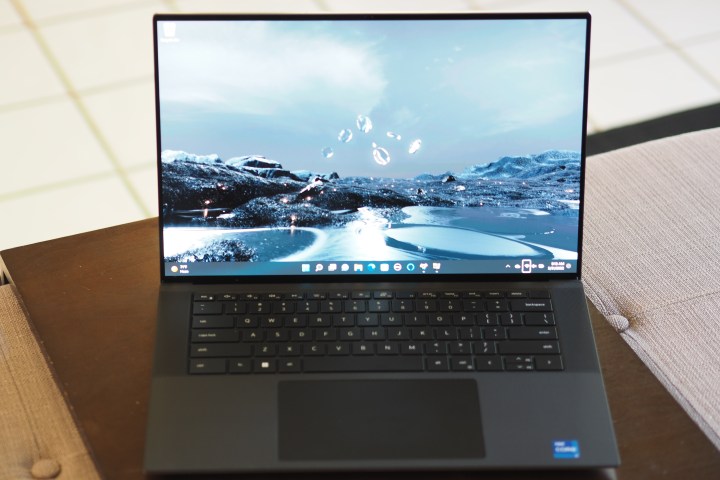
The MacBook Pro 16 comes with just one display option, a Liquid Retina XDR (Mini-LED) 16.2-inch, 16:10 panel running at a 3,456 x 2,234 resolution. It offers awesome contrast at 475,200:1 for inky blacks and brightness at 475 nits, with a wide color gamut (100% of sRGB and 90% of AdobeRGB), and outstanding accuracy at a DeltaE of 1.04 (less than 1.0 is considered excellent). The Mini-LED display can also get incredibly bright when playing high dynamic range (HDR) content, making the MacBook Pro perhaps the best streaming media laptop available.
The XPS 15 offers a variety of 15.6-inch, 16:10 displays including non-touch Full HD+ (1,920 x 1,200), touch-enabled UHD+ (3,840 x 2,400) IPS, and 3.5K (3,456 x 2,160) OLED panels. We reviewed the OLED version, and it was a truly spectacular experience. Brightness was high at 391 nits, although considerably less than the MacBook Pro 16, and the contrast was 381,130:1 with deep blacks. The color gamut was wider than the MacBooks at 100% of sRGB and 96% of AdobeRGB, with significantly better accuracy at 0.42.
Both displays are excellent for creators, with wide and accurate colors and true blacks. They’re also great for productivity work and media consumption. Call this category a draw.
| Dell XPS 15 (OLED) |
Apple MacBook Pro 16 (Mini-LED) |
|
| Brightness (nits) |
391 | 475 |
| AdobeRGB gamut | 96% | 90% |
| sRGB gamut | 100% | 100% |
| Accuracy (DeltaE, lower is better) |
0.42 | 1.04 |
| Contrast ratio | 381,130:1 | 475,200:1 |
Portability
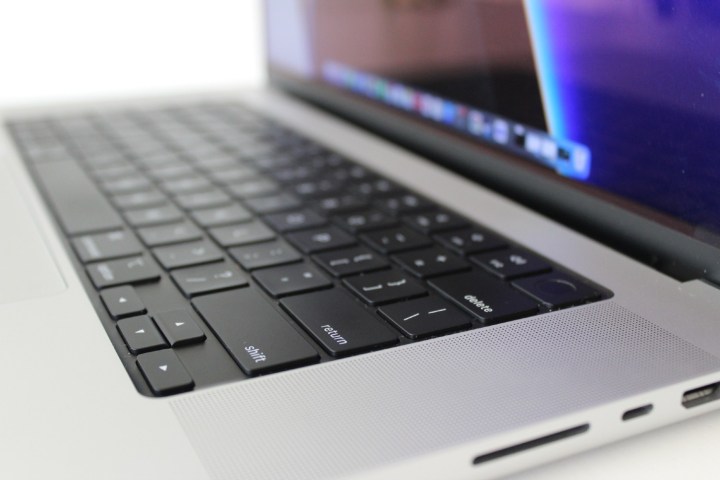
The MacBook Pro 16 has a larger 16.2-inch display, so its chassis is slightly larger than the XPS 15’s, but both enjoy slim display bezels that allow for as small a chassis as possible. The MacBook is thinner than the XPS 15 at 0.66 inches versus 0.73 inches, but it’s slightly heavier at 4.8 pounds versus 4.62 pounds. In short, both are equally portable — or non-portable, depending on your tolerance for size and weight.
The XPS 15 is available with an 86 watt-hour battery, while the MacBook Pro 16 comes with a whopping 100 watt-hours of battery capacity, the most that’s allowed on airline flights. Even more important is the incredible efficiency of Apple’s M1 Pro and Max chips.
Simply put, the MacBook Pro 16 offers extraordinary battery life for such a powerful laptop with a large, power-hungry display. It almost doubles the XPS 15’s battery life, which itself isn’t bad for a portable workstation. You’ll get two days of work out of the MacBook Pro 16, while you’ll get a single day from the XPS 15. And even if you push the CPU and GPU, the MacBook Pro 16 might make it through a full day’s work.
| Dell XPS 15 (Core i7-13700H) |
Apple MacBook Pro 16 (M2 Pro) |
|
| Web browsing | 9 hours, 43 minutes | 18 hours 35 minutes |
| Video | 11 hours, 46 minutes | 23 hours 11 minutes |
The MacBook Pro 16 is the better laptop, but it’ll cost you
Here’s where the XPS 15 and MacBook Pro 16 diverge the most. Dell offers a configuration of the XPS 15 that starts at just $1,499 for an Intel Core i5-13500H, 8GB of RAM, a 512GB SSD, Intel Arc A370 graphics, and a 15.6-inch Full HD+ non-touch display. You can spend as much as $4,349 for a Core i9-13900HK, 64GB of RAM, a 2TB SSD, an Nvidia GeForce RTX 4070, and a 3.5K OLED display.
The MacBook Pro 16 is a much more expensive laptop, especially at the low end. The entry-level configuration is $2,499 for an M2 Pro with 12 CPU cores and 19 GPU cores, 16GB of RAM, and a 512GB SSD. At the very high end, you can spend as much as $6,499 for an M2 Max with 12 CPU cores and 38 GPU cores, 96GB of RAM, and an 8TB SSD.
The MacBook Pro 16 is the better all-around laptop, with more performance at the high end, incredible battery life, and a spectacular display. It’s the best choice for the most demanding creators. Dell’s XPS 15 is a better mainstream laptop, however, coming in at thousands less when fully configured, and offering its own excellent performance. Which is right for you depends entirely on how deep your pockets are.

